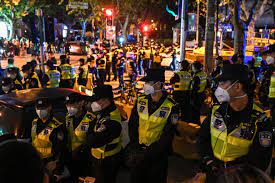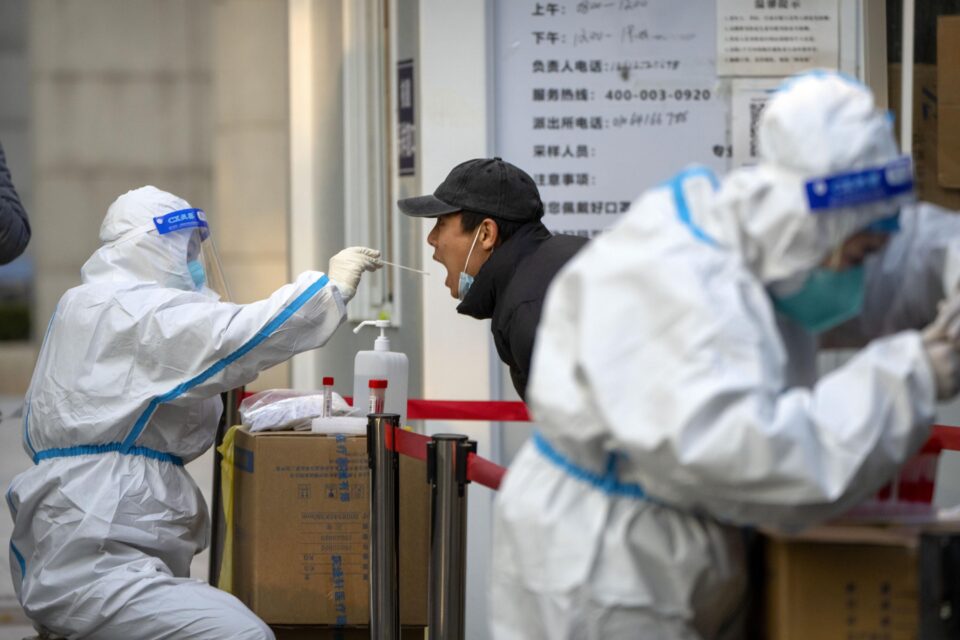The past several days have been startling, even for China, where there is frequently a disparity between official narrative and empirical evidence. Five deaths from COVID-19 were reported on Tuesday, increasing from the two that were reported the day before and the first in the nation since December 3. There were formally none on Wednesday. An internet search, however, reveals a different tale. Numerous hearses are lined up at a crematorium in Beijing, remains are piled in hospitals wrapped in orange plastic, and patients on ventilators are crowded onto a ward floor.
The leadership of the Chinese Communist Party (CCP) decided to relax its strict zero-COVID policy and permit the virus to spread, which has resulted in an increase in cases and a significant load on the healthcare system. This reversal is extremely startling. The self-proclaimed “commander-in-chief” of a “people’s battle” against the virus, President Xi Jinping, gave his Politburo orders to adhere “resolutely” to “dynamic zero-COVID” on November 10. Over the course of the summer, residents of Shanghai were forcibly imprisoned in quarantine facilities as a result of a single case in a nearby housing complex.

At the Communist Party Congress, Chinese President Xi Jinping sends a message of continuity.
But on December 7, zero-COVID was all but abandoned because China’s senior medical advisor now compares the Omicron variation to the “fever.” An app that has been controlling every aspect of life in China for the last three years was abruptly put down on December 13. On Sunday, officials in the central city of Chongqing ruled that COVID-19 patients with minor symptoms or no symptoms could “go to work as normal.”
The abrupt U-turn highlights the brittleness of strongman leadership as well as the CCP’s extreme paranoia in the face of popular unrest, like the protests that broke out in late November in various Chinese cities. The starting point was the at least 10 fatalities in an apartment building fire in Urumqi, a city in western China, which analysts attributed to strict pandemic regulations that kept inhabitants inside their houses. Officials refute this. Numerous people gathered on streets and university campuses across the nation to protest, yelling “we want freedom, not PCR testing” and even “down with Xi Jinping.”
According to Yanzhong Huang, senior fellow for global health at the Council on Foreign Relations, the abrupt relaxation of limitations that followed “may be considered as a success for people power.”
The policy climbdown is shocking nonetheless. Demonstrators were never close to organizing a political opposition, but China’s security forces were quick to locate and apprehend them. Wen-Ti Sung, a researcher specializing in Chinese elite politics at the Australian National University, claims that they “never completely coalesced into a single, cohesive, politically actionable message.” However, the depth of resentment that zero-COVID sparked is probably what frightened Xi. Rich Shanghainese, troubled students with slim employment prospects, and foreign workers in southern factories all rebelled in different but connected ways against its privations and associated economic fallout. Their worries were well-founded; calculations indicate zero-COVID may have cost the Chinese economy $384 billion and 2.2 percentage points less GDP growth.
Perhaps it’s not unexpected that a CCP that emerged from a popular revolution would be most afraid of the anger of the people. But in reality, only a small percentage of the 303 autocrats who lost their positions of authority around the world between 1946 and 2008 were overthrown by popular uprisings; instead, more than two-thirds were overthrown by elite coups. Leaders like Xi should be watching their backs rather than fearing a crowd on the horizon, according to the lesson. It is obvious that he also practices the latter, as Xi has steadfastly shielded himself from possible competitors by accepting a third leadership term in November, breaching convention. He has also surrounded himself with a group of loyalists and lackeys.
The issue might be found here. The concern was always that the homogeneity of this new leadership would impair the standard of its policymaking. The fact that it has struggled with passing its first big test—the smooth exit from zero-COVID—hasn’t helped allay those worries, claims Sung. The administration wants to make changes after realizing the economic costs of zero-COVID. Local leaders, who for the previous three years had been evaluated primarily on their ability to eradicate the virus, were apprehensive. The national tracking system had to be dismantled, for example, in order for the central leadership to exert more pressure on them. Prepare for the abrupt change in direction. China currently finds itself torn between Xi’s two festering paranoias—fear of the populace and fear of challengers within the party.

There could be severe repercussions. Despite government denials, the increase in cases will undoubtedly cause a significant number of deaths because there has been little or no population contact to the virus and because domestic immunizations are only moderately effective. Some estimates even forecast over 1 million deaths. China’s medical institutions will experience their “darkest hour” by next month, according to Zhang Wenhong, a prominent Chinese physician frequently compared to America’s Dr. Anthony Fauci.
Rather, a fresh propaganda offensive has taken control. In the past, the pandemic turmoil in the West was seen as a failure of liberal democracy. A superior political structure was demonstrated by China’s achievement in eradicating the virus. However, on December 12, the People’s Daily newspaper, a mouthpiece for the CCP, presented zero-COVID as a necessary stopgap to buy time while the virus’s severity lessened and efficient cures were established. It was always planned for dismantling, the story said. It urged readers to “Be the first person responsible for your own health.”
There are numerous, obvious issues with this account. There should have been more done to immunize the elderly if this opening up was long anticipated. Government statistics show that just 42% of people over 80 had received all three doses of the vaccine. Currently, clinics are turning away patients in need of boosters because to a lack of inventory. More potent foreign immunizations may have been administered to those who were most at risk. Nobody anticipates the nationalistic CCP to accept the mRNA vaccinations the U.S. provided China on Tuesday. Additionally, Paxlovid and other potent antivirals should have been kept on hand; instead, one Chinese website sold out of them in just 30 minutes.
Given the rapidly declining effectiveness of vaccines over time, public health professionals also question the wisdom of opening up about six months after the majority of Chinese had received their most recent vaccination. Not to mention that there are only a few weeks left until China’s Spring Festival, which sees 200 million Chinese cram into trains and buses for lengthy trips to ancestral villages with at best rudimentary medical facilities. This migration represents the largest annual movement of people in history.
Even healthcare personnel were taken aback by the reversal, according to Huang.However, the CCP’s account has already been written. On December 14, officials ceased disclosing diseases that were believed to be “asymptomatic,” which in China is frequently strictly defined as those that aren’t verified by a chest scan. Then, on December 20, authorities announced that they would only count as COVID-19 deaths those who had tested positive for the virus and passed away from pneumonia or respiratory failure—excluding anyone who had complicating illnesses, as is commonly the case with elderly people. The purpose is to emphasize that China sustained the least damage from COVID-19 of any significant nation.
I have no doubt that a lot of Chinese will buy the propaganda. However, a sizable portion of people have had their eyes opened by the failure of zero-COVID, the suicide deaths, and the illnesses that could have been prevented but became worse in an ultimately ineffective effort to eradicate the virus. The protests merely serve to demonstrate that the party is, in fact, flawed and susceptible to popular outrage, and that the people actually possess more power than was previously believed. The Chinese civil society, which has had limited room to operate for years, will find this to be quite promising, according to Sung. Ironically, they have only thus far pushed the CCP to act callously rather than exerting oppressive control.
One Shanghai resident, commenting to TIME on the condition of anonymity out of concern for official repercussions, adds, “I don’t see how anybody can have confidence in China anymore.” “Disturbance and unexpected events are one thing; a government yanking the rug out from under you is quite another.”





